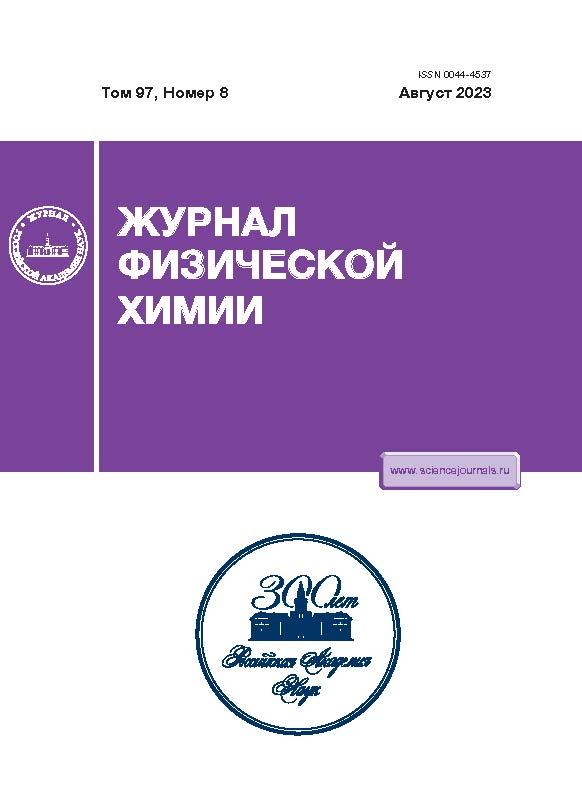DFT Study of Potential Barriers and Trajectory of CO2 Adsorption/Desorption As Well As Dissociation on Clusters Simulating Fe (100), Fe (110), and Fe (111) Facets
- Авторлар: Tolkachev N.N.1, Pokusaeva Y.A.1, Bogdan V.I.1
-
Мекемелер:
- Zelinsky Institute of Organic Chemistry, Russian Academy of Sciences
- Шығарылым: Том 97, № 8 (2023)
- Беттер: 1181-1191
- Бөлім: ФИЗИЧЕСКАЯ ХИМИЯ ДИСПЕРСНЫХ СИСТЕМ И ПОВЕРХНОСТНЫХ ЯВЛЕНИЙ
- ##submission.dateSubmitted##: 26.02.2025
- ##submission.datePublished##: 01.08.2023
- URL: https://permmedjournal.ru/0044-4537/article/view/668680
- DOI: https://doi.org/10.31857/S0044453723080289
- EDN: https://elibrary.ru/RAAPNO
- ID: 668680
Дәйексөз келтіру
Аннотация
Density functional theory calculations (DFT) were performed to investigate the Fe-facet effect on the CO2 potential barrier as well as trajectory of CO2 adsorption. It was found that potential barrier of CO2 adsorption on Fe (111) is almost absent (~0.01 eV). At the same time, potential barriers of CO2 adsorption on Fe (100) and Fe (110) are 0.10 and 0.26 eV, correspondingly. The most stable configuration of CO2 adsorption on different Fe facets under consideration is CO2 adsorbed on Fe (111) with heat effect –1.16 eV, whereas adsorption energies of CO2 on Fe (100) and Fe (110) are –0.87 and –0.15 eV, correspondingly. Found values are in good agreement with literature data. Most energetically favorable trajectory of the CO2 adsorption passes through 2-fold adsorption site (located near two neighbor Fe atoms) in case of flat Fe facets (100) and (110). Unexpectable tend to spontaneous dissociation of CO2 molecule on desorption stage was found at distance ~2.66 Å above Fe (100) surface. Analysis of electron spin distributions allows one to conclude that dissociation is caused by excitation of CO2 molecule accompanied with rearrangement of the spin density of the both CO2 molecule and surface Fe (100) atoms rather than charge transfer. CO2 dissociation on adsorption stage on Fe (100) facet was not found as well as it was not observed over other Fe facets both on desorption and on adsorption stages.
Негізгі сөздер
Авторлар туралы
N. Tolkachev
Zelinsky Institute of Organic Chemistry, Russian Academy of Sciences
Email: nick33@ioc.ac.ru
119991, Moscow, Russia
Ya. Pokusaeva
Zelinsky Institute of Organic Chemistry, Russian Academy of Sciences
Email: nick33@ioc.ac.ru
119991, Moscow, Russia
V. Bogdan
Zelinsky Institute of Organic Chemistry, Russian Academy of Sciences
Хат алмасуға жауапты Автор.
Email: nick33@ioc.ac.ru
119991, Moscow, Russia
Әдебиет тізімі
- Wang W., Wang Sh., Ma X., Gong J. // Chem. Soc. Rev. 2011. V. 40. № 7. P. 3703.
- Yang H., Zhang Ch., Gao P. et al. // Catal. Sci. Technol. 2017. № 7. P. 4580.
- Wang W., Gong J. // Front. Chem. Sci. Eng. 2011. № 5. P. 2.
- Bogdan V.I., Pokusaeva Ya.A., Koklin A.E. et al. // Energy Technology. 2019. № 7. P. 1900174.
- Boreriboon N., Jiang X., Song Ch., Prasassarakich P. // Top. Catal. 2018. T. 61. P. 1551.
- Pokusaeva Ya.A., Koklin A.E., Lunin V.V., Bogdan V.I. // Mend. Comm. 2019. V. 29. P. 382.
- De Smit E., Cinquini F., Beale A.M. et al. // J. Am. Chem. Soc. 2010. V. 132. № 42. P. 14928.
- Solymosi F. // J. Molec. Catal. 1991. V. 65. P. 337.
- Freund H.-J., Roberts M.W. // Surf. Sci. Rep. 1996. V. 25. № 8. P. 225.
- Nassir M.H., Dwyer D.J. // J. Vac. Sci. Technol. A. 1993. V. 11. P. 2104.
- Heß G., Baumgartner C., Petkova A., Froitzheim H. // Surf. Sci. 2004. V. 572. P 355.
- Seyller T., Borgmann D., Wedler G. // Ibid. 1998. V. 400. P. 63.
- Meyer G., Reinhart E., Borgmann D., Wedler G. // Ibid. 1994. V. 320. P. 110.
- Glezakou V.-Al., Dang L.X. // J. Phys. Chem. C. 2009. V. 113. P. 3691.
- Wang H., Nie X., Chen Y. et al. // J. CO2 Util. 2018. V. 26. P. 160.
- Wang H., Nie X., Guo X., Song Ch. // J. CO2 Util. 2016. V. 15. P. 107.
- Kwawu C.R., Tia R., Adei E. et al. // Phys. Chem. Chem. Phys. 2017. V. 19. P. 19478.
- Jonsson H., Mills G., Jacobsen K.W. “Nudged elastic band method for finding minimum energy path of transitions.” in “Classical and Quantum Dynamics in Condensed Phase Simulations” Edition B / Eds. J. Berne, G. Ciccotti and D.F. Cooker. Singapore: World Scientific, 1998, P. 385.
- Liu X., Sun L., Deng W.-Q. // J. Phys. Chem. C. 2018. V. 122. P. 8306.
- Neese F. Wiley interdisciplinary Reviews − Computational Molecular Science. 2012. V. 2. № 1. P. 73.
- Weigend F., Ahlrichs R. // Phys. Chem. Chem. Phys. 2005. V. 7. P. 3297.
- Rappoport D., Furche F. // J. Chem. Phys., 2010. V. 133. P. 134105.
- Weigend F. // Phys. Chem. Chem. Phys. 2006. V. 8. P. 1057.
- Hellweg A., Hattig C., Hofener S., Klopper W. // Theor. Chem. Acc. 2007. V. 117. P. 587.
- Perdew J.P., Burke K., Ernzerhof M. // Phys. Rev. Lett. 1997. V. 78. P. 1396.
- https://www.open-mpi.org/software/ompi/v3.1
- Momma K., Izumi F. // J. Appl. Crystallogr. 2011. V. 44. P. 1272.
- http://www.jmol.org/
- Allouche A.R. // J. Comp. Chem. 2011. V. 32. № 1. P. 174.
- Li H.-J., Ho J.-J. // J. Phys. Chem. C. 2010. V. 114. P. 1194.
- Taifan W., Boily J.-F., Baltrusaitisa J. // Surf. Sci. Rep. 2016. V. 71. № 4. P. 595.
Қосымша файлдар













